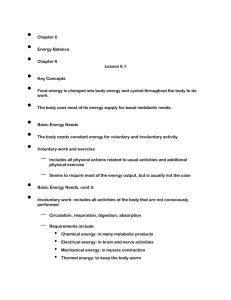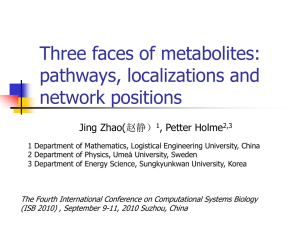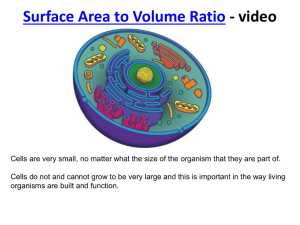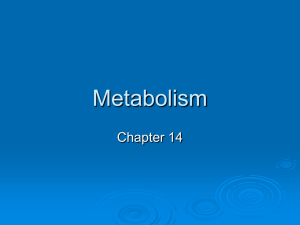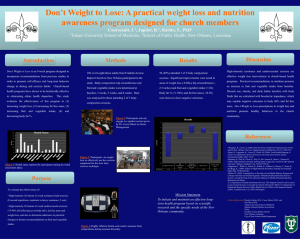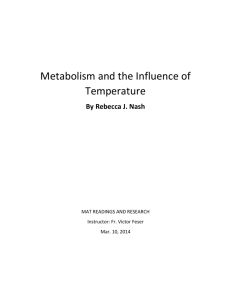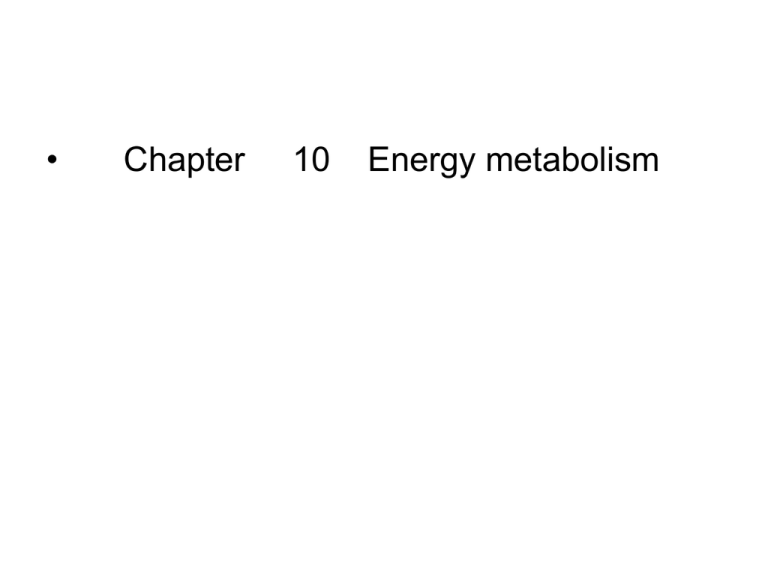
•
Chapter
10
Energy metabolism
Energy
• Most important item in diet.
• Feeding standard are base on energy need.
• defined as the ability to perform work.
• Derived from most organic compound ingested by an animal by
partial on complete oxidation of molecules from ingested or stored
form.
• Energy transfer from one chemical reaction to another bound
found as ATP and others.
• All life process and animal activities such as walking, chewing,
digestion, maintenance of body temp. maintenance of ion
gradient, hepatic synthesis, glucose absorption, storage of
glycogen, fat, protein, body metabolism (movement of energy
from one from to another),
• Including:
* from chemical energy to heat.
* from chemical to mechanical energy (肌
肉活動).
* from chemical to electrical (葡萄糖氧化成
神經組織之電子活力).
• Energy terminology
• chemical energy is typically measured in terms
of heat produced.
• Cal: heat required to raise 1g water from 14.5℃
to 15.5℃
• 1Cal = 4.1855 joules,
• Kilocalorie (Kcal)
• Megacalorie (Mcal).
• Fig 10.1 Schematic representation of the energy
flow, NRC (1981)
• Gross energy: adiabatic bomb
calorimeter as the increase in temperature
• Of a known amount of water upon
complete oxidation of a sample.
• Carbohydrate: 4.1 Kcal/g
• Protein :5.7 Kcal/g
• Fat
:9.4 Kcal/g
•
others in Table 10.1
物質之能量含量
能量的利用
食物 → 能量 → 供身體利用
↘ 代謝廢物 (CO2 & H2O)
↓
排出體外
能量的利用
營養素
↓ 進入細胞內
將儲存性電子能
↓
ATP (腺核 三磷酸)
↓
作功、活化酵素 (提供能量)
產熱
泌乳牛的能量代謝
Digestible energy (DE):
• DE = IE-FE
• FE loss range 10% or less to 80% or more.
• *fecal loss include: undigestible food residue.
•
: sloughing of cell from GI tract lining.
•
: undigested microbes and their metabolic byproduct
• True digestible energy (TDE)
•
= IE-FiE-HfE-GE
•
= IE-(FE-FeE-FmE)-HfE-GE
• FE = fecal energy
• Fie = fecal energy of food origin
• FeE = fecal energy of endogenous
• FmE = fecal energy of metabolic source
• HfE = heat of fermentation
• GE = gas losses
• Total digestible nutrient (TDN )
• TDN = DCP+DNFE+DCF+2.25(DEF)
• 1Kg TDN=4.4Mcal DE
•
*DE和TDN並未考慮分佈於消化(digestion)
和代謝(metabolism)過程所損失的能量, 高
估高纖維原料之可利用能量.
Metabolizable energy (ME)
• ME = IE-FE-UE-GE
•
考慮消化與代謝過程所損失之能量.
• Gaseous product of digestion (GE)
•
消化道中因微生物發酵所產生之氣體損失之能量, 以methane
•
(CH4) 為主要, H2, CO2, acetone, ethane, H2S少量.
•
*GE大約為IE之8%, 如intake增加則降至6-7%.
•
*UE = energy from nonutilized absorbed compound (UiE),
•
end product of metabolic process (UmE),
•
end product of endogenous origin (UeE).
• *攝取excess protein, forage consumed, oil, must be detoxified
product時, UE會增加.
• *ME= 0.82×DE
•
*因為需收集gas, 所以較少被測定.
• 用於家禽之能量評估
• **N-corrected metabolizable energy (MEn):
• 經氮矯正 (Nitrogen retained or lost)後之
ME.
•
MEn =ME-(k ×TN)
•
k is constant, 7.45Kcal/g of nitrgen
retain in body tissue. (哺乳動物) 8.22Kcal
/g for birds.
•
TN is total nitrogen retain or lost.
•
*ME之測定較常應用於家禽
Net energy
• NE=ME – HI (heat increment)
•
–HF(heat fermentation)
•
-HP(heat production in the fasting
animal).
• NE is available to the animal for
maintenance, various production purposes.
Heat increment (HI)
• The heat production associated with nutrient
digestion and metabolism.
• The metabolism in the liver is the most of HI.
• Lean meat for dog: HI amount to 30-40%of GE.
Fat 15%, sucrose 6%, starch 20-22%.
• The amount of HI : if most of the material is
absorbed and deposit in the tissue, the HI us
very low. Incomplete protein result in oxidation of
most amino acid and a high HI.
Heat production (HE)
• The energy lost from a animal system in a form
other than as a combustible compound.
Including:
• Basal metabolism: energy required in the fasting
and resting state. This energy is used to
maintain essential cellular activity. respiration,
blood circulation.
Basal metabolic rate (BMR)= animal in a
thermoneutral environment, postabsorptive
state, quiet, sexual repose ,resting.
= as fasting heat production (FHP).
•
•
•
•
•
Heat production =
+heat of activity.
+ heat of digestion and absorption
+ heat of fermentation
+ heat of waste product formation and
excretion
+ heat of thermal regulation
+ heat of product formation
單胃動物生合成之能量效率
• Heat increment (HiE) = 在適溫帶時,動物消
耗食物所產生之熱.
•
= HdE + HfE + HwE + HrE
• Recovered energy (RE)= defined as the
energy retained as part of
the body or voided as a useful product.
• RE = tissue energy + lactation energy (or
other product energy).
• Net energy (NE)
• RE = ME-HE
Methods of measure heat
production (HP)
•
•
•
•
•
•
•
•
•
•
Calorimetry
Animal loss heat = sensible heat (convection, conduction,
reduction) evaporation heat (excreta, skin, respiratory tract)
by directly calorimetry.
by indirectly calorimetry
heat production = result of oxidation of organic compounds.
= calculated from O2 consumed and CO2 produced
and excreted urea(不完全燃燒), and gas
(methane)
HE = 3.886 O2+1.200 CO2-0.518 CH4-1.431 N
O2, CO2, CH4 in liter; N in grams (尿氮).
因為CH4, N很少→省略
•
•
•
•
Carbon-Nitrogen balance
此法乃利用energy retained於體內, 乃以protein及fat之型態, 而
CH2O很少, 所以測定C, N intake 及C, N的loss (from尿, 糞, CO2,
CH4), 而body protein含16%N及51.2%C.
N balance: (intake-loss)×6.25=body protein accretion.
體蛋白質量×0.512=C accretion in body protein.
(intake-loss)c -body protein C=C in fat
C balance ÷ 0.746(assuming fat contains 74.6%) =accretion fat.
Calculation of the energy content of protein and fat accretion=
recovered energy
C
•
Comparative slaughter
•
Animal飼餵正常之飼糧 2週, 分成兩組
一組屠宰→分析body composition, energy
content.
另一組經飼養一段時間, 後屠宰→分析body
composition, energy.
Retained energy (RE) = body energy
difference between two groups.
Metabolic weight ,Metabolic size
•
•
•
Scaling coefficient for weight
能量產生與body surface有關, body
surface = W 0.67
Brody and Kleiber顯示interspecies之間
以W0.75較適當, 且被引用.
Basal metabolism
Factor affecting basal metabolism
Maintenance
•
Maintenance energy expenditure vary with
•
1. age: 呈curvilinear decrease with age.(越成熟, tissue
及organ生長 緩慢).
2.body size: mean 70Kcal/W 0.75, sheep 63Kcal/W
0.75, cattle 77Kcal/W 0.75.
3.breed: Bos indicus required 10% less than breed of
Bos taurus cattle dairy purpose require 20% more than
beef breed.
4.sex: male greater than female about 15%.
5.physiological state: pregnancy, lactating多20%.
6.season: summer(維持所需能量最高), winter(最低).
7.temp.
8.previous nutrition: low level是high level intake的
58%.
9.grazing expend more energy than penned to be 1020%.
10.production: 高生產量→高維持量.
•
•
•
•
•
•
•
•
•
Energy expenditure and the
environment
•
*
• heat production by “tissue metabolism” and
“fermentation in GI”
• dissipate heat by “evaporation”, “radiation” and
“conduction”.
• 兩者(heat production, heat dissipate)受維持體溫恆定之
調整.
• Fig 10.6 showed 環境溫度與動物之恆溫調整.
• 適溫帶下, HE之產生不受溫度影響, 而受metabolism, feed
intake , efficiency of energy use.
• 適溫帶下, 體溫受heat dissipation之調控.
• 當溫度高於適溫帶時 (Tuc): *蒸發散熱↑, 藉流汗, 喘氣.
•
*攝食量↓.
•
*因dissipating heat增 加, 代謝
•
速率↑, 體溫↑.
• 當溫度低於適溫帶時 (Tic): *因正常之metabolism
fermentation 產生之HE不足以維持體溫, 增
•
加代謝, 產生熱 (稱之cold
•
thermogenesis).
• Tuc與Tic之溫度 (適溫帶範圍)受下列二因素而改變:
• 1.rate of heat production (因feed intake, body condition,
physiological state的影響).
• 2.animal ability to dissipate or conserve heat.
• Animal acclimatization
• modification in behavior: 利用生理現象
(physiological adaptation)增加或減少熱產生.
• 如: basal metabolism
•
respiration rate
•
distribution of blood flow to skin lungs
•
feed, water intake
•
digesta passage
•
hair coat
•
shivering sweating
• *nonstructural components之消化率因high level of intake
•
•
•
•
•
•
而降低.
* △de = (L-1)(0.107-0.113de)
△de 指每增加1倍維持量時, 消化率之改變.
L :指維持量時之採食量.
De :指採食量為1倍維持量時之消化率
例: 如採食量為2倍維持量時, 消化率之改變量.
*1倍維持量之採食量時, 消化率為70% (0.7), 而提高至兩倍
維 持量時, 其消化率則為
• △de = (2-1)〔0.107-0.113(0.7)〕=0.038
• 所以2倍維持量之採食量, 其消化率為0.672
•
5 倍維持量之採食量, 其消化率為0.558
•
*消化率越低者, 採食量越高, 其消化率受影響之程度越
明顯.
•
Energy termination used in ration
formulation and feeding standards
•
•
•
•
•
•
GE
DE, TDN: swine horse
ME: poultry
DE,TDN,ME: sheep
NEm: 77Kcal× BW 0.75
NE g
end
• *以methane (CH4) 及尿損失之能量, 隨採
食量增加, 消化率降低 而降低
• (intake↑, dig↓→loss of CH4 and urine
energy↓).
• 所以消化率↓, GE及UE之損失量↓, 所以ME
受feed intake影響之程度較DE為低.
Utilization of ME
• ME used for maintenance, tissue gain, lactation,
muscular activity.
維持所需之ME (MEm)= 1.fasting heat production (HE) +
•
2.heat of activity (HjE) +
•
3.heat energy required to maintain
body temp +
•
4.heat increment of the food
consumed (HjE)
• MEm = HE (維持生命過程所需之能量).as recovered
energy (RE)=0
MEm used two types:
1.service function
=組織或器官維持正常功能所需,
•
如circulation, respiration, liver and kidney work
•
(detoxification, maintenance of body osmolarity and
•
pH, gluconeogensis) and nervous function, 約佔
•
HeE的35-50%.
2.cell maintenance function
= ion transport, protein turnover, lipid turnover.(即
metabolic functions), 此三部分為主要需能之function, 約佔HeE的
•
30~50%.
•
其他亦含glycogen synthesis, ketogenesis, urea,
•
RNA, DNA, synthesis---------•
--
•
•
•
•
•
•
•
•
Retained energy
energy retention as tissue energy, milk, conceptus.
1. NEg = energy content of body gain.
= heat of combustion of the body protein and fat
gains which is 5.6 and 9.4 Kcal/g ,respectively.
RE as a function of weight and rate of gain (EBG)
RE= 0.0635W 0.75+EBG 1.097
2. NEl = energy content of the milk produced.
3. NEy = energy retained in the fetus and associated
tissues.

